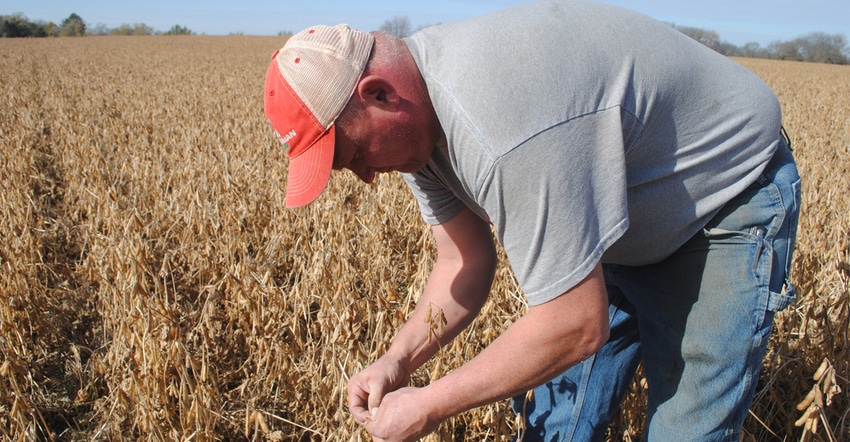
The weather didn’t cooperate and the season was challenging for double-cropping winter wheat and soybeans in east-central Nebraska, but Dodge County farmer Chad Christianson isn’t discouraged at all. Instead, Christianson has “tripled down” on the practice, planting about 120 acres in winter wheat this past fall, with plans to double-crop those acres with soybeans next summer.
After planting winter wheat for the first time in fall 2017, Christianson’s 40-acre wheat field endured a cold, wet spring, particularly in April. This was followed by a wetter-than-normal May and June. The weather delayed wheat harvest about two weeks later than planned.
Christianson harvested his wheat July 4 after an extreme weather event caused a fair amount of lodging. He recorded a yield of 64.4 bushels per acre, with 14.2% protein. He planted soybeans into the wheat stubble four days later on July 8, trying to get a profitable double crop off the field, and to build soil health and biology in the process. He harvested his soybeans on Nov. 1 after an extremely wet fall, gaining a yield of 36 bushels per acre.
“I was hoping to see more yield on the soybeans. But if you compare that to all of the replanted, flooded fields this season, it was pretty good,” he says. There were spots in the field that yielded over 50 bushels.
“This was supposed to be a learning year for us in this system,” Christianson says. “We definitely learned a few things that we can build on going into next year with this system. The experience for us was positive enough for us to continue the work and the research.”
In mid-October, Christianson planted 120 acres of winter wheat to two different varieties — the same WestBred-Cedar variety he planted last season, plus a longer-season Kansas Wheat Alliance variety called Zenda. The wheat was planted into good soil moisture but didn’t get past the seedling stage before the weather turned colder, he says.
“By planting two varieties, we can see how they compare,” Christianson adds.
Working with Nebraska Extension educator Nathan Mueller, Christianson included a University of Nebraska winter wheat trial in his fields, which consists of four short-season West Bred varieties.

BUILDING SOIL: Building up his soil health and increasing soil microbial activity is the main goal of double-cropping winter wheat and soybeans for Dodge County farmer Chad Christianson.

Christianson also plans to test different varieties and maturities on soybeans, to see how they respond to double-cropping situations. After the harvest of the Zenda wheat in summer, he will try a 2.0 maturity Merschman Navajo 1920 LibertyLink GT27 variety. In the WB-Cedar wheat field, he will follow with a 2.6 maturity Merschman Comanche 1626LL variety. He will also be testing a 3.6 maturity Merschman Monroe 1736LL variety on 20 acres of his double-cropped wheat.
“Yield is important, but the whole point of double cropping is to increase soil biology and microbe activity,” Christianson says. “I think the wheat yields could be 20 bushels better, and if we can get the soybeans planted two weeks earlier next year, it should make a big difference,” he explains. “Mother Nature just put us a through a difficult season this past year.”
It takes more than one year of double cropping to move the needle on soil health. “It’s too early in the game to notice,” Christianson says. “But the practice intrigues me enough to keep going. If I can continue to do this on the same farm for more than three years, it will be interesting to do some Haney soil health tests and to see how the microbes are increasing.”
You can learn more about double-cropping winter wheat with soybeans in eastern Nebraska by contacting Mueller at [email protected].
About the Author(s)
You May Also Like






